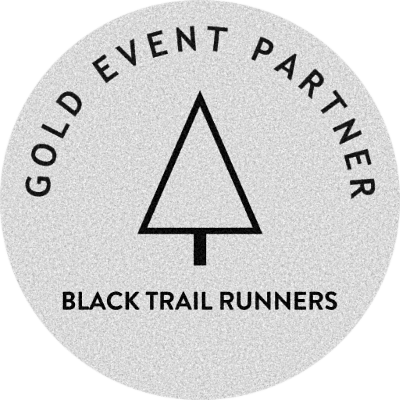5 Feb 23 by James Elson
Spine Race 2023
The Spine Race is one of the few ultra distance events in the UK that resonates beyond the niche end of the running world that we live in. A lot of that has to do with the time of year, the second week of January is not a bumper time for ultrarunning, for good reason. Most organisers stay well clear of the predictably horrible and potentially hazardous conditions. But the pictures and video we've all seen down the years of bog, snow, ice, rain and frankly misery, somehow captivate, when sat in the warm and the dry as we watch the dots inch closer to the finish at an agonisingly slow rate.
But the main thing I think the media can't convey and really hit home for me running the event this year, was how much darkness there is. You can't shoot that, and for me it ended up being dark for seemingly almost all of the time I was on the trail.
268 miles along the entire Pennine Way, non-stop and in January is a formidable task. I'd entered ten years previously and failed to start and then a clash with my sons birthday each year had always ruled me out. But this year they'd moved the race back a week. It's one of the few races in the UK that I'd consider to be on the very difficult end of the spectrum and one of even fewer I hadn't had a go at so I thought it was time to see what it was all about.
The report is long and specifically aimed at those interested in running the Spine race, or one of the other sister events. There is a lot of focus on some of the practical side. Logistics, admin, kit etc are almost more important than physical preparation for what is ostensibly an adventure race, far more than it is a running event. An expedition is a good way of looking at it. I will go into depth with reference to the more tangible aspects, because as a runner coming into this years' event I found the information was out there but took a good deal of time to collate and even then, there were quite a few suprises on race day. What is the race really about? How much kit do I need? What are the best options for mandatory kit trading off weight for actually needing to use those items in a pinch. How does the race unfold and where will I get support?
As a retailer, as I went through my own kit for the race, I began to reach out to suppliers of the best items that we didn't already have in store- and put together a collection of the best kit, footwear and clothing for this unique event. You can find full details on that below this report and the store collection here.
You can read the full kit list post here, or scroll to the bottom of this report.
This may mean that unless you are planning on running the Spine, some of this is a bit heavy or dull and for that I'm sorry, but I will try to keep the story going.
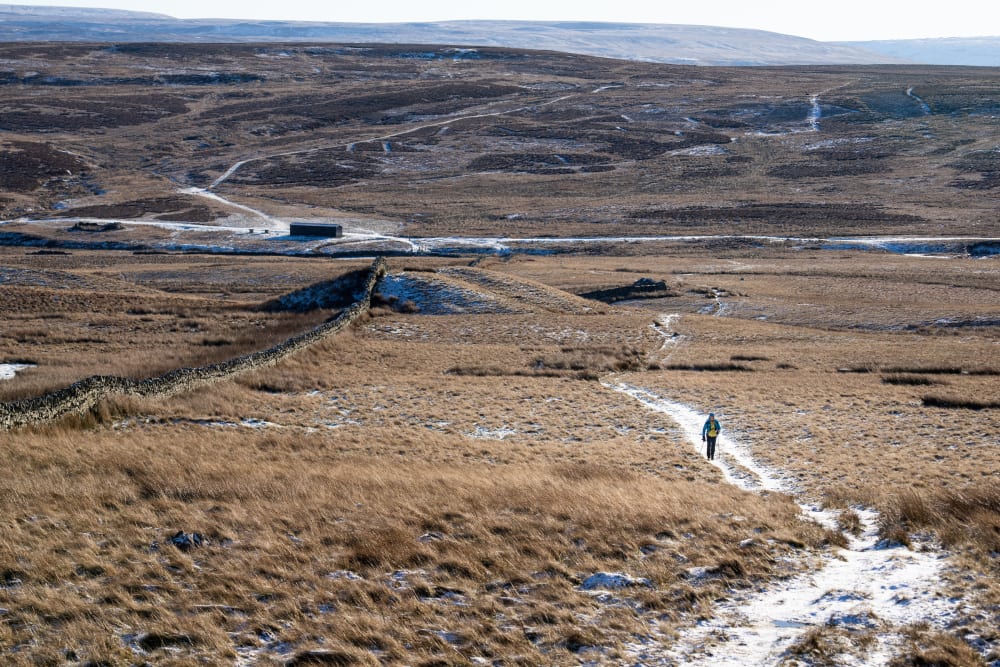
James crossing Cotherstone Moor Mile 135 at the 2023 Spine Race (Photo c/o Steve Ashworth)
Preparation
I am not a great lover of lots of kit, in fact I complained after TDG back in September that I'd had enough of packing a big drop bag and thinking carefully about what I might need 100 hours into a race. Well, let me tell you that only got significantly worse here.
I spent as much time sorting kit out as running and hiking in training for the race.
The physical preparation is easy to cover. I began after a month of rest post-Tor. Two x 200 mile plus races in four months is a big toll and I wouldn't rush to do that again, but it was just how it worked out for me this time. During November I got some steady consistency away, then a big week to start December - with a low key 50km event followed by a four day recce on the second half of the Spine with one of our coaches Eddie Sutton and Jayson & Kim Cavill. It was brilliant fun, a great way to see the course and left me excited about the race in a way I hadn't been before. I'd also run the third section with a friend of mine and five time finisher Matt Neale. And seen various other bits when pacing John Kelly and Damian Hall on their FKT attempts. The only bit I hadn't seen was the first 90 miles. These recce's were most useful for testing kit but particular footwear. I felt I really had that dialled in and you can read a much more in depth look at the footwear solution I found and which worked, at the foot of the report.
And on that note - as a retailer of ultrarunning gear, all that happened as I went sourcing the best kit, was that we started to stock it. Both so I could get it a bit cheaper for me (!!) and so we could pass on a collection of kit that was all in one place for runners interested in the race - with first hand, real world advice. We don't stock it all but we're getting there. All of the links take you to the best place to find each product. It might seem salesy but believe me when I say I think the biggest saving is actually hopefully on people's time trying to find good advice and being able to ask questions about kit/ shop from us at the same time. We're here for the detail.
However, we are not the authority on Spine Race kit. If you have any questions or want to check if what you have meets kit requirements for the race, then you should contact the Spine Race and Lindley Chambers who heads up their kit side of things, via his email [email protected] . You can also read his advice and tips on kit and kit check on this page here.
Back to the story.
The final weeks were a blow for me. I got ill on Christmas Day which wiped out the peak weeks and left me struggling to be fit on the start line. Probably a similar story to most people! But the start line beckoned and I was sure I was well enough to give it a decent shot.
The Start
The start of the race is in Edale, Derbyshire, a lovely village at the foot of the Kinder plateau. To be eligible to start, one must of course pass an epic kit check, see again further down the post for that detail.
Dinner the night before in the Ramblers Inn where we were staying was low key and ideal, the pub is between the start and Registration. The main thing on the agenda was the forecast. It looked like we were going to have a miserable half a day to start, low temps, wet sleet or snow, frozen ground up high and some wind. But after that it just looked bitterly cold. I was delighted which I think was the general consensus....
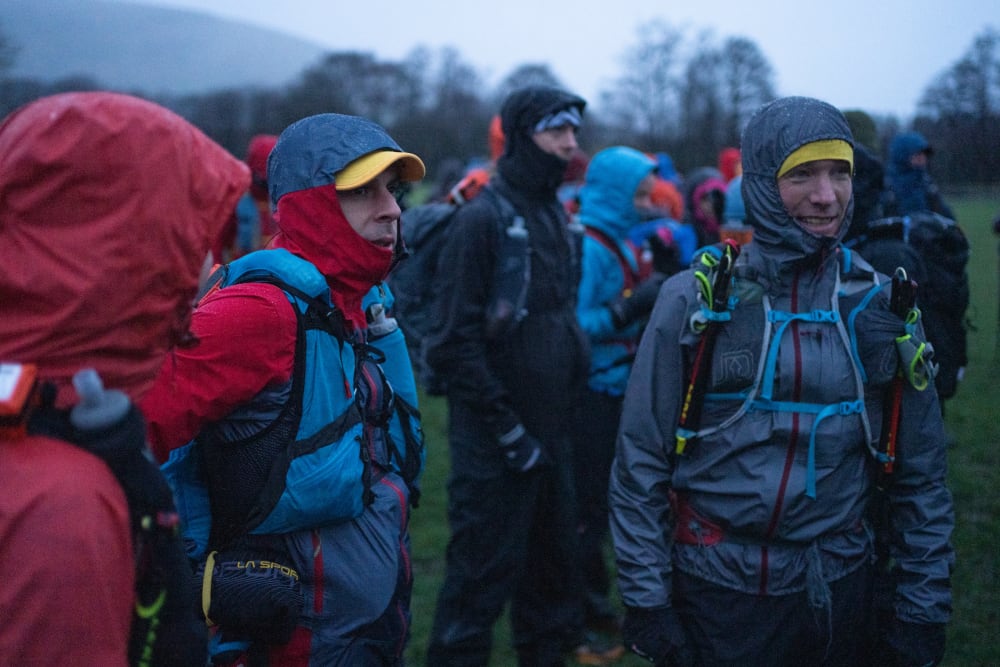
At the start line with Kim Collison and Eddie Sutton. Weather classicly Spine-esque (Photo c/o Steve Ashworth)
The start itself was a muddy wet affair, very Spine like and off we went at 0800 Sunday into the wild.
Day 1 to CP1 at Hebden Bridge is about 46 miles, mostly in daylight for me. It was a bit frenetic as these things always are and whilst the ground was frozen underfoot in places, it was 'a tiny bit wet' in others.
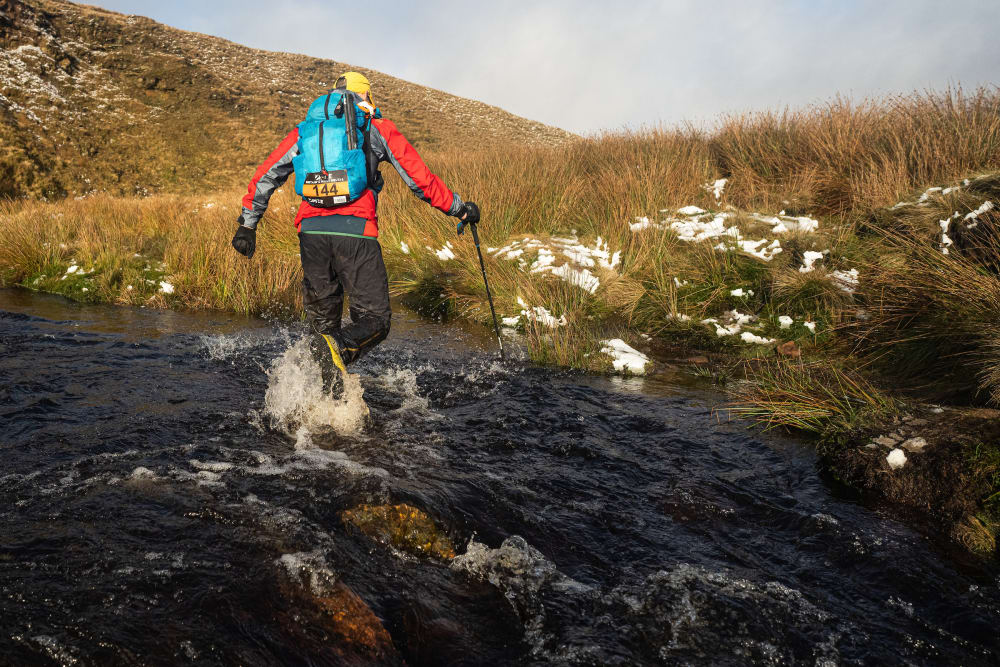
Triple River Crossing at Black Hill on Day One (Photo c/o Steve Ashworth)
It's not an especially hard section, Kinder was a bit of an icy mess but is short lived. The second half of this section is mostly flat and good going so quick time is made. But I felt dreadful as I approached Stoodley Pike, the huge monument marking the end of the tops before the check point. I just felt like the virus hadn't passed, I felt ill. And i couldn't see how that couldn't leave me feeling worse and worse over the coming few days. At Hebden I asked what the protocol was for dropping. I ate a meal served by the wonderful volunteers, decided to go to bed for several hours and just lay there checking train times and moaning on whatsapp to people who probably needed to go to sleep. But then I got up and ate again, with all timings already out of the window I took all of my experience in hand and looked at it logically. I felt shite, but well enough to get to the next check point. It was mostly dry out, in fact it was snowing on the moors which was fine. Let's just go one stage at a time, break it down into tiny sections and take it a bit at a time. See how far I could get, you can't drop at CP1.
Leaving Hebden I motored past half a dozen people, because I was now towards the back of the pack having initially arrived there in 11 hours and leaving in 16. This helped my mental state, unfortunately. Sad as it is when you're moving well versus others around you it makes you feel artificially better than you had before. Then I caught up with Eddie Sutton who was having her own issues, notably with fueling. We formed up and spent much of the next 24 hours together, as we had done in the recce's, just forging ahead to Hawes. We shivered in a tent in Lothersdale with the tri club, trying to stay warm. Enjoyed a breakfast of pain aux chocolat and a coffee on the baby changing table in the toilets at Gargrave. Passed Marco Consani and Graham Connolly having a sleep on the ground. And wend our way to Malham Tarn check point. These small oases in such long sections were welcome. A 30 minute maximum allowed stay time meant a quick freeze dried meal and then off and away. Next up, Fountains Fell and Pen Y Ghent and Eddie was having a harder time moving well on the icy descents. It seemed wise to try to stick together through to Hawes however, certainly more enjoyable and our invisble bungee was just long enough that I'd ping ahead and she'd catch me up before i got cold.
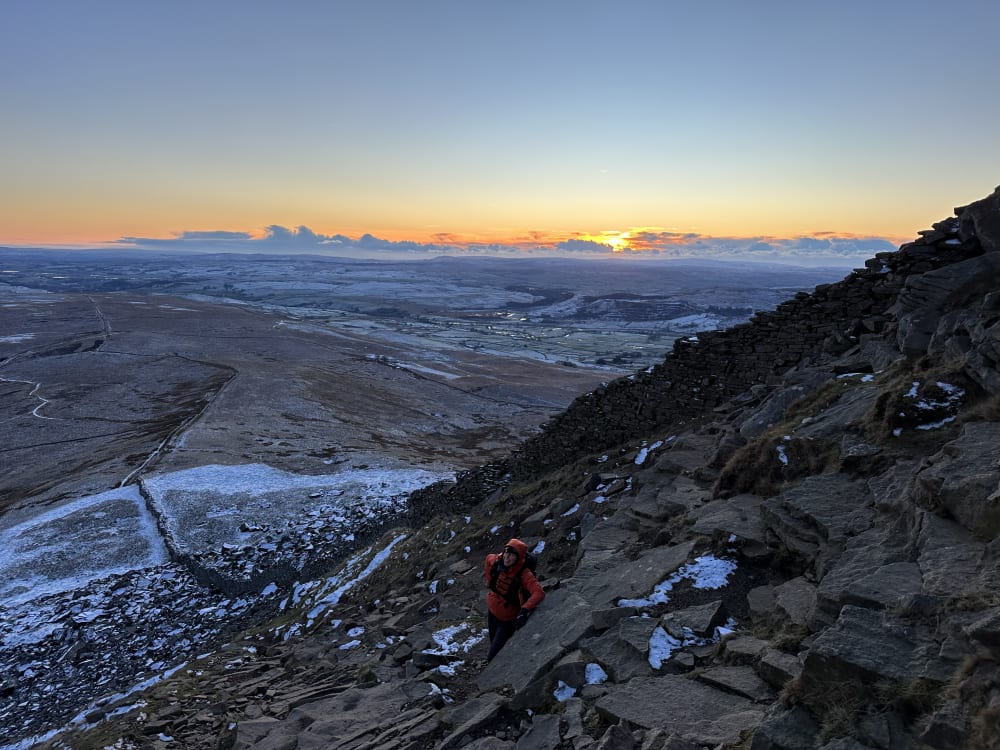
Eddie on the flanks of Pen-Y-Ghent at Sunset
Down into Horton, things got a little uglier as the temperature very tangibly dropped off of a cliff. It had been cold, well below zero but it felt like it fell to a whole new level as the sun disappeared for the next 16 hours. I ran ahead to Horton and started sorting kit and a brew down in the toilet block as a bloke I'd met in the village explained there was no MRT station or check point there. Eddie had some navigation issues, so I went back up the road to find her and then back to the haven of the toilet block. We got all of our kit on, and I mean ALL of it. Before having a couple of hot drinks, getting the remaining food together and setting off for the 15 miles or so to Hawes. 100 metres later we were inside the warm cosy interior of the caving club check point that had been just up the road, drinking coffee and eating a cheese sandwich. Oh well! The Cam High Road sucks. It's a long gradually ascending drag and the cold was real. I was just about the right side of warm enough but that was with a very strong marching pace.
Then the descent to Hawes and with 39 hours elapsed, 108 miles were in the bag. Just 160 to go.
Hawes to the Finish
Four hours at Hawes of which two were broken sleep, then off and up Great Shunner Fell. Eddie left just in front of me and we started the climb together before I pressed on a little over the summit and across to Keld reading room, where David Bone made me a lovely cup of tea. On to Tan Hill I passed Eddie again and made my way across Sleightholme Moor, one of the boggiest least enjoyable sections of the PW, but which on this day was frozen almost solid. The ice was inches thick in places, truly spectacular and I was extremely grateful for that! Then I hit Gods Bridge and Half Way, where Steve Ashworth had popped out to shoot some more of the race and got me attempting to look like a runner past the reservoirs before I motored on to Middleton Check Point.
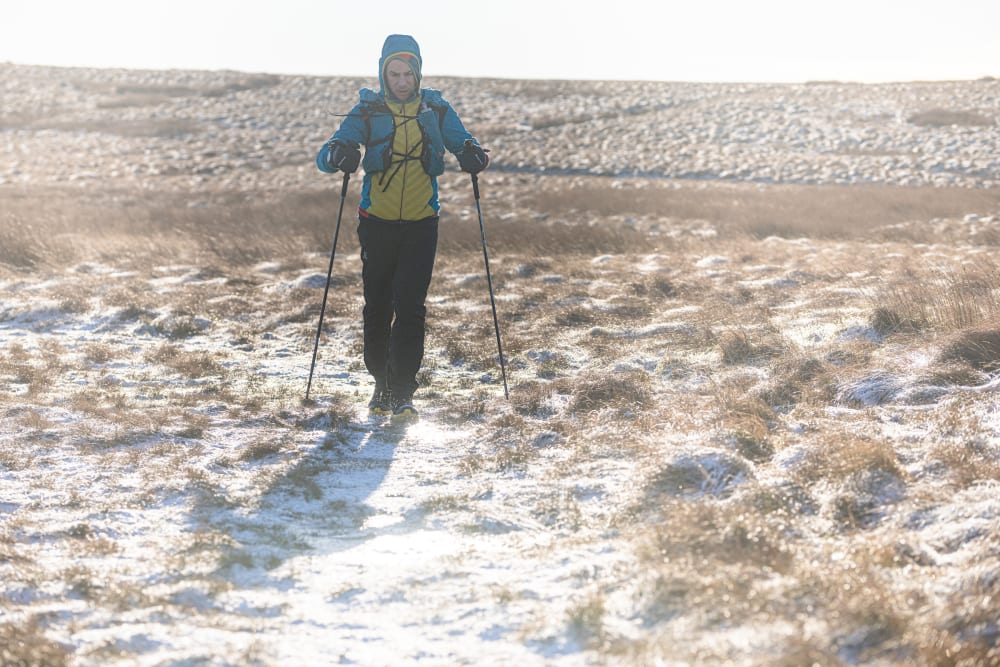
Half Way There Photo: Steve Ashworth
Middleton was the best laid out check point on the course, with big tables to sort gear when you came in, a nice big open room with a fire for eating and resting, and then bunk rooms for some rest. Which by now were quiet. The way the race spaces out even by this stage is pretty dramatic. From the frenetic noisy first two CPs up to this point of total calm. The volunteers here were sensational. From Jess and his crew in the kitchen, to the medics looking at feet and the people helping with kit sort and check out in the main arrival room.
It was at Middleton that I ran in to Matt Neale. We'd been leap frogging the whole way, saying hi and bye at regular intervals. But our races aligned here. I had two hours sleep to Matt's three, we got up, ate a second plate of Jess's chicken korma and decided to head off at the same time into the third night.
We absolutely motored along the flat path past High Force, through the icy rocky mess of Falcon Climts which in my opinion is the best bit of the course. That remote, dead end valley which ends in Cauldron Snout waterfall feels wild and remote and I think it's spectacular. Cauldron Snout was iced up, the rocks were hard to handle and despite Matt and I having a lot of experience in the mountains (huge self pat on the back here as completely coincidentally we happen to be Finishers 72 and 73 of the Big Three UK Rounds), it was sketchy at times and it was easy to imagine some runners having a bit of a melt down in there. We stopped to put more clothing on just the other side in the lee of one of the incredibly remote farms and from there, picked up second placed lady Hannah Rickman who was an absolute pleasure to share the trail with. She was bright and clearly enjoying the adventure with a big smile despite the bitter cold. Over High Cup Nick, the descent to Dufton marking 100 miles to go was the first time the sleep monsters hit hard. The path to Dufton is a big wide open track and I was asleep on my feet. I led down there but I would constantly stop and ask if we were going the right way - Matt was incredulous, 'of course we are there's literally no other path' so on we stumbled. When we hit Dufton, we made our way to the small hall where there's again a 30 minute time limit on your stay. We lay on the floor and woke up 27 minutes into that 30, with a volunteer gently prompting us to get up and get out. This photo may sum up the sensation of that moment.
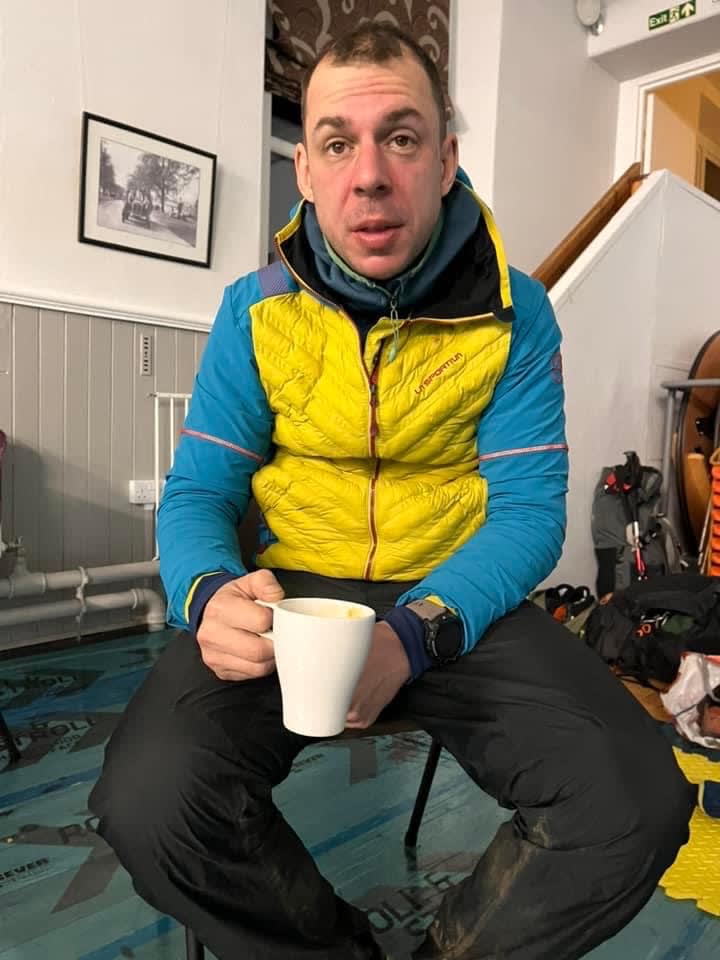
Looking good at Dufton (Photo: Lizzie Faithfull-Davies)
The climb up Cross Fell went ok, but it was so cold up on the plateau and the snow had drifted in to cover all of the slabs so it was tough going. It felt truly wild and Arctic up there, by far the most epic part of the course. Eventually we crested the ridge as the sun rose, and nipped into Gregs Hut for John Bambers incredible spicy noodles and a tea. What an absolute haven that is and everybody is rightly truly grateful to John and his team for manning it. It's a real highlight of the race.
Matt and I ran pretty much the entire 10km descent down the track to 'Annie's house' in Garrigill where we had some tea and toast, she welcomes all of the runners , shoes and all, into her kitchen. WOW. Then the final few miles to Alston we shared with Hannah again. Alston is a real moment I think, you know you are going to be ok from there, it's 80 miles to go but feels like the beginning of the end. A cracking meal and a good sleep for a couple of hours and Matt and I departed again together, via the Spar where we bought a special meat pie to celebrate with in the toilets at Greenhead - because there's nothing else for 40 miles on this section! I'll distill the rest down to the best anecdotes. We moved really well through the remainder, making up many places and not conceding any, overall we'd saved a lot in the first half and that allowed us to really enjoy the second.
At Greenhead we got into the toilets and lay down for a few minutes, grabbed a space on the floor and sorted ourselves out. Some luxury pie was eaten as one of Matt's army mates surprised Matt, hannah and I with some tea in the middle of the night. In a disabled loo. In a deserted car park. On Hadrians Wall. Only in the Spine Race.
The Wall is a stunning section, though tough and we ran that well, but in the woods the other side we started to lose the plot to sleep again. So we lay down in the trees for literally 3 minutes until the cold woke us up. God it was horrendous moving again after that.
Eventually we made Hornystead Farm, four miles out from the last check point where there was some soup on the go and Matt and I enjoyed a lovely nap together on the mattress. I promised I'd never tell, but.... It felt good to finally get some warmth after a bitterly cold 15 or so hours.
We sped on to Bellingham where we planned one more sleep before dealing with the final section. It was absolutely freezing in the check point and the sleeping accomodation was mat and bag on the wooden floor, which was a shame and impacted how much rest we got. But we sorted ourselves out and got off.
The one issue we had over the last two days of the race was that our CP breaks were coinciding with the 8 hours of daylight, so practically the entire second half of the race was done in darkness. That, was hard.
We moved really well to Byrness, it took us four hours to cover nearly 16 miles and we were well pleased at how we were going. We had our final 30 minute limited stay at the check point there with my old friend Duncan Anderson providing some much needed grub having volunteered literally all week - and then up and over the Cheviots. It was seriously cold up there, but beautiful. At times the trail was compacted by runners who had gone before and there were some faster miles, but the snow had drifted in on others and there was no path at all. Knee deep and worse post-holing up the Cheviot itself was truly something special to finish with, maybe a 50 minute mile up there, but then it was almost all down hill and we were still super strong. Matt remarked that if someone had asked us just to crack on and do another stage or two or three we probably could have just fine. It felt like we were right in the rhythm of the race.
Steve Ashworth came out to take some final photos and video a few miles out from the finish. Job done.
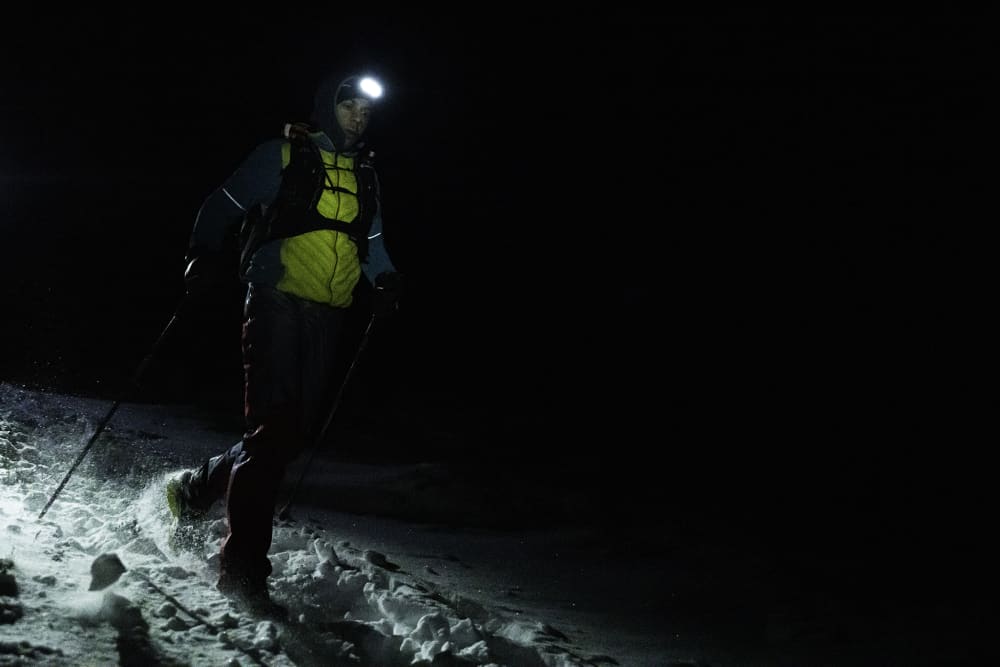
Descending the Schill, the final hill on the course (Photo c/o Steve Ashworth)
And just like that we were in Kirk Yetholm. A low key finish somewhere around 0430 in the morning, a shake of the hand, quick plate of food and back down the motorway to the National Running Show.
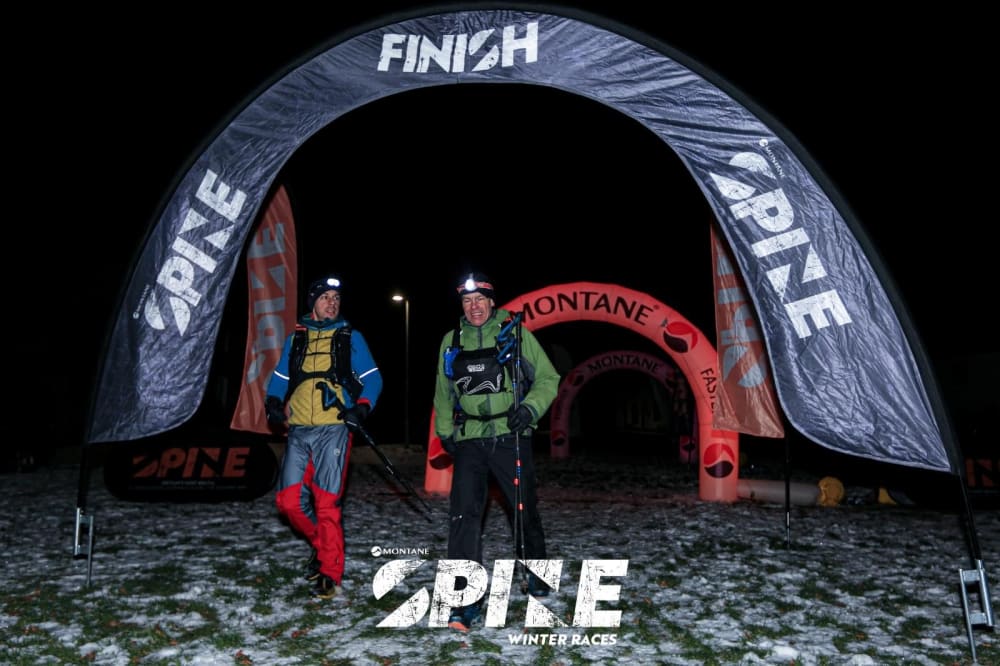
Photo c/o The Spine Race
What's it all about
The questions I have been asked dozens of times at the Run Show and the Arc of Attrition which we worked both of in the 8 days post race, were:
- Have you recovered yet?
I recovered quickly. My feet were good and there were no substantial aches or niggles so I was able to sleep well, straight away, albeit with the regular night sweats in full gear - they are pretty horrible. Each day I napped in the afternoon then slept a full night and was relatively quickly, back a normal routine. We ran out on the coast path on the Saturday, 8 days after finishing and that went relatively well!
Compared to the Tor, the damage was incomparably less. After TDG I had bad blisters, horrendous all body swelling, needed to sleep every 90 minutes or so for about a week, couldn't feel my toes for 3 weeks afterwards and generally felt wrecked.
Perhaps because I expected to be worse this time, and it wasn't so bad, all was a success!
- Would you do it again?
Probably not - never say never but - probably not. Prefaced with I am extremely proud of the finish and it was a true adventure - a rare thing in this world, with an incredible community of people around the race which make it very special indeed. But for me, the joy in running is why I do it, not just the challenge of finishing something. In the last two years I've run the Arc of Attrition 100 twice, the Paddy Buckley, the Charlie Ramsay, TDG and the Spine. They are all up there in the difficulty stakes, and I'd do any one of them again apart from the Spine. Three main reasons. The amount of darkness at the Spine means that you are severely limited in being able to actually enjoy the surroundings. And for us with our CP times falling in daylight hours, my memory of the race is bascially a ten foot bubble of headlamp and my watch gpx trace. Secondly, the amount of kit and terrain underfoot makes running extremely difficult - it is just extremely slow going. Thirdly, the Pennine Way is wildly beautiful in places, but atrociously managed in others. There are far too many low lying field paths that have been destroyed by farming, both animals and vehicles. Lots of very bleak moorland. Sections which you frankly cannot believe are part of our oldest National Trail. Even in summer it is in many places, a mess. There are jewels in her crown, incredible highlights that are up there with the very best scenery and trails we have here, but you miss so many because of the dark and they are at times spaced out by miles and miles of terrible ground.
The reason to do it again would be to be part of the wonderful Spine community. The volunteers were out of this world and clearly the race has a magic feel around it which is second to none. It will mean the world to you if you can finish this one.
- How hard was it?
Very difficult, terrain, weather, amount of kit, amount of darkness, overall distance - all make it extremely hard. Not as hard as the Tor in my opinion. And one must always look at the finisher rate/ times. To finish within 7 days is I believe a reasonable ask. There are runners who struggle to finish our events in 30 hours, who will routinely finish the spine a half a day inside the cut off. But to push it at the Spine, to race it hard, is truly up there in the overall list of things I've personally had a go at.
KIT AND LOGISTICS
This area of the post is specifically designed to look at the detail of all aspects of the kit, footwear, apparel, nutrition and miscellaneous items that you need to think about in order to compete safely and successfully in the Spine Races or indeed, for winter in the mountains.
- Click here to visit the store collection on our website, containing the majority of these products.
- Click here to watch a longform video going into all of the kit for the Spine Race with James Elson (YouTube)
- Click here to read James' race report from 2023.
- Click here to listen to James' recap podcast of the 2023 event.
- Click here to listen to a British Ultrarunning Podcast conversation between James, Dan, five time finisher Matt Neale and 2023 Mens Race Winner Damian Hall.
- Click here to listen to the Tea and Trails podcast with Eddie Sutton on her 2023 Spine Race. Eddie is a Centurion Coach and third place finisher in 2023.
This video accompanies this post, going into further detail on all of the items below as well as the drop bag and how to think about packing for the race.
Clearly a huge caveat needs to be placed at this juncture. Every single person emerging from the Spine will have a different view on kit, how in functions, what minimum requirements are vs what you actually need to carry.
You need to think very carefully about what you need to carry/ have access to and not just what's on the mandatory kit list. The kit list is there as a safety net and often just in case of emergency. What you actually require to stay safe and perform well at the Spine Race goes far beyond it.
We also need to be realistic about cost and what you do and don't need to buy. Some of the kit is very expensive plus there is of course a large energy cost to production and transport in a lot of cases. So consider what you have already that is fit for purpose, what can be borrowed and what can be hired. As time goes on and we are able to put the time and resource into it, hiring kit is something we'd like to get into - many already do this. The facebook group here is a valuable resource in borrowing kit or getting advice on how to look after it.
Cheaper alternatives are available for everything, always look at the compromise though: Weight vs Packability vs Price. We've picked out the best balance of those three things, in our opinion.
And on that note - as a retailer of ultrarunning gear, all that happened as we went sourcing the best kit, was that we started to stock it. So that we could pass on a collection of kit that was all in one place for runners interested in the race - with first hand, real world advice. We don't stock it all but we're getting there. All of the links take you to the best place to find each product. It might seem salesy but believe me when I say I think the biggest saving is actually hopefully on people's time trying to find good advice and being able to ask questions about kit/ shop from us at the same time. We're here for the detail.
However, we are not the authority on Spine Race kit. If you have any questions or want to check if what you have meets kit requirements for the race, then you should contact the Spine Race and Lindley Chambers who heads up their kit side of things, via his email [email protected] . You can also read his advice and tips on kit and kit check on this page here.
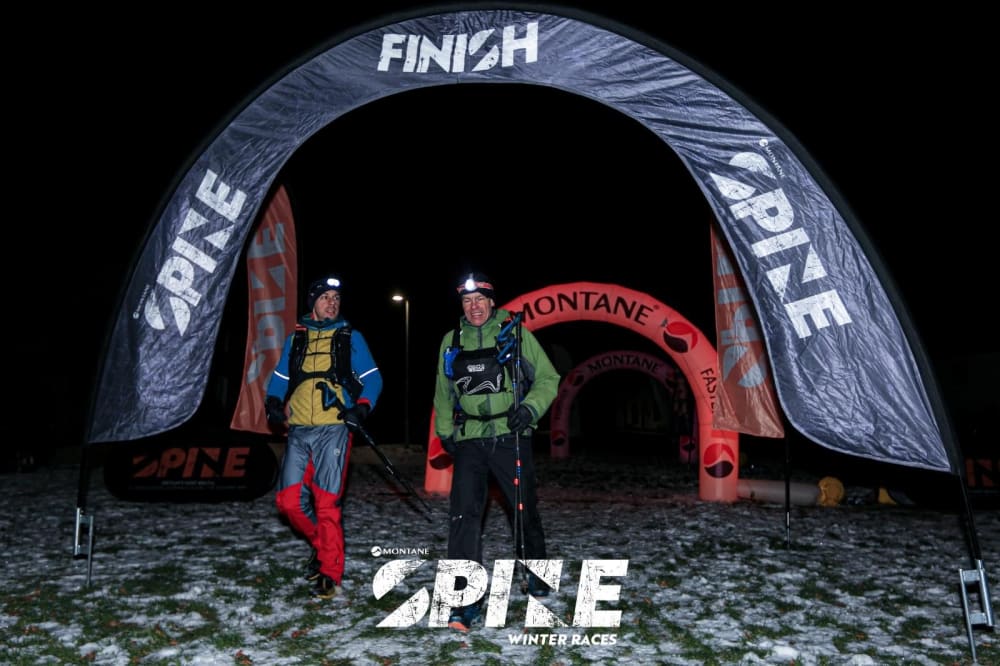
What I've done here is distilled down my experience not just at the Spine but of a nearly two decades of racing in all conditions, utilising a wide range of winter kit over and over again - as well as organising more 100(+) mile ultra distance events than anyone else in the country! I know there will be some people who have no idea of who I am so I have included a short bio at the end of this post.
This kit has been used, not actually mainly in racing but in training and on days out on the hill, in winter. You must get used to using the kit, particularly working out what footwear and what layering systems work for you. I am around 65kg, 5ft7 and without tooting my own horn, tend to move towards the mid to the front of the pack in events. I would say days out over the Wainwrights in winter were a turning point for me. Learning to read the forecast, particularly with regards to wind speeds at height, anticipate clothing requirements, navigate in the dark and mist with map and compass and scramble/ climb very difficult ground - these are the skills that make me feel most comfortable in terrible weather. A lot of my racing might also seem irrelevant but you draw on the experience of everything that has gone before, in events like the Spine. Races/ Rounds I've run that help contribute to choices here include Tor Des Geants, Arc of Attrition, Lakeland 100, Western States, Bob Graham, Paddy Buckley, Charlie Ramsay, Leadville, Lakeland, 4Deserts Series (antarctica being the most cold weather specific). But more so things like the Wainwrights in winter, crossing Iceland on foot and many long days out by myself.
Finally you will find kit suggestions and comments throughout this text which features my own kit. Firstly from two of our team runners - Debbie Martin-Consani who has finished the race twice including a win at the 2022 edition. And Edwina Sutton who finished third in the 2023 race. Finally, from 2023 Mens winner Damian Hall.
A link to the full mandatory kit list for 2023 is available here. All of the below kit meets the criteria for the event.
Footwear:
Clearly, managing your feet is one of the handful of major things to concentrate your energy on. For some time as a team we had been waiting on the La Sportiva Cyklon Cross GTX to come out. We'd sat in a team meeting back in April and Jono Wyatt had pulled a pair out and previous race winner and PW Record Holder - John Kelly - sitting to my right, had asked on the spot if he could possibly just take them home with him. They are effectively an insulated, waterproof, lightweight shoe - that looks like a boot due to the gaiter. The sole unit is La Spo's grippiest rubber. The upper is soft, warm and you can dial it in tight or back it off using the boa system. Then there is a Gore Tex gaiter coming up to ankle height, so effectively there are two waterproof layers to the shoe. This kind of shoe has moved the game on with regards to protection from winter/ very wet or cold conditions. It feels like you are wearing a lightweight shoe, whilst getting the protection of a mountain boot (not crampon compatible as the sole is not rigid enough - great with microspikes of course). Others were still wearing regular trail shoes and asking more of their socks but for me whether you are running up the front or scraping cut offs, this shoe does it all. The other model I had in my armoury was the La Sportiva Blizzard. This is again a Gore-Tex shoe with a debris gaiter, and has a metal stud matrix built into the sole unit - essentially built in nano-spikes so you can run across ice without issue (note these will not pass kit check, you still need a separate set of spikes or yaktrax).
The other component of course, is socks. I hadn't worn waterproof socks since the Last Desert Antarctica in 2008. But I got hold of some Dexshell Compression mudder socks and quite frankly they became the most important piece of kit I had. They are impermeable to both water, but also to debris. And at knee height you have to be in a very significant bog or river to get water in the top. If that does happen, they then insulate that water like a wetsuit, and keep your feet warm.
I had no liner sock, just the Dexshell. I started in the Cyklon Cross. Because it was minus 2-3 in the valleys and 6-7 on the tops all week, every hard surface was covered in ice so I then used the Blizzards for Day 2 and 3. Before going back to the Cyklon Cross for the last two sections.
All four of the runners mentioned on this post including myself, Debbie, Eddie and Damian all used the same DexShell sock for this race.
2022 Womens race champion Debbie Martin-Consani used a liner sock in combination with the DexShell and had just as much success with her feet - Debbie talked about her foot route in a post-race intstagram post here. Liner socks should be thin, it is well worth experimenting with both options in your training. Damian Hall comments: 'I too use DexShells and tend to wear a toesock as a liner. The only problem I've had is from feet being too warm in conditions less severe'. Again, test them in training.
With the Dexshell Sock, and then the Cyklon Cross/ Blizzard I had zero blisters (i had one small bit of skin come off at the finish because i tore off a bit of preventative tape too soon with wet skin underneath), zero hot spots, never once got cold feet and always had the grip I needed. I took my shoes and socks off in at the 144 mile check point and the medic asked me where I'd washed my feet - they stayed that clean and clear. The Blizzards - after 40 or so hours began to make my feet tender, I think where the sole is more rigid and the spikes less forgivining but they were priceless for the icy rocks, hence the switch back to the Cyklon Cross. I take half a size up in both to allow space for the thicker Dexshell Sock.
So as an N of 1 sure, but if you want to get through the Spine without foot issues, there's a good system to try. This is more of an invidivual area than almost any other part of your race strategy, besides nutrition.
Separate Spikes or Yaktrax are part of mandatory kit. Nanospikes won't pass kit check. I would always carry a Yaktrax for speed and weight, but also have my Kahtoola Microspikes in the drop bag. These are essentials for any winter mountain day anyway, will see plenty of use! I've had my Yaktrax since 2008, still going strong.
La Sportiva Cyklon Cross
La Sportiva Blizzard
Dexshell Mudder Compression Socks
Kahtoola Microspike
Yaktrax
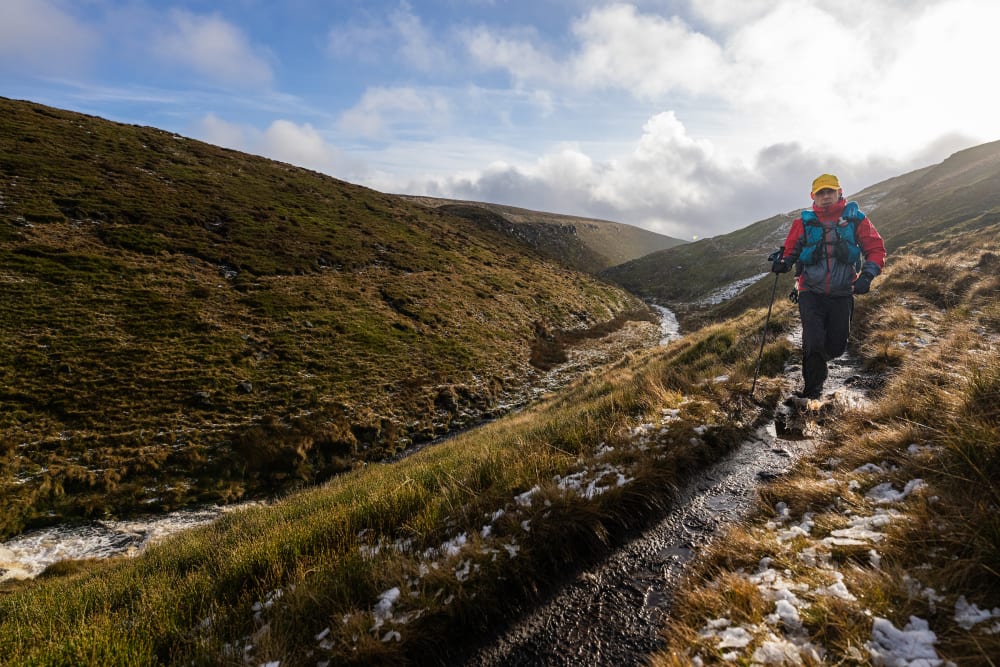
Freezing waterlogged paths - but no water ingress or foot problems.
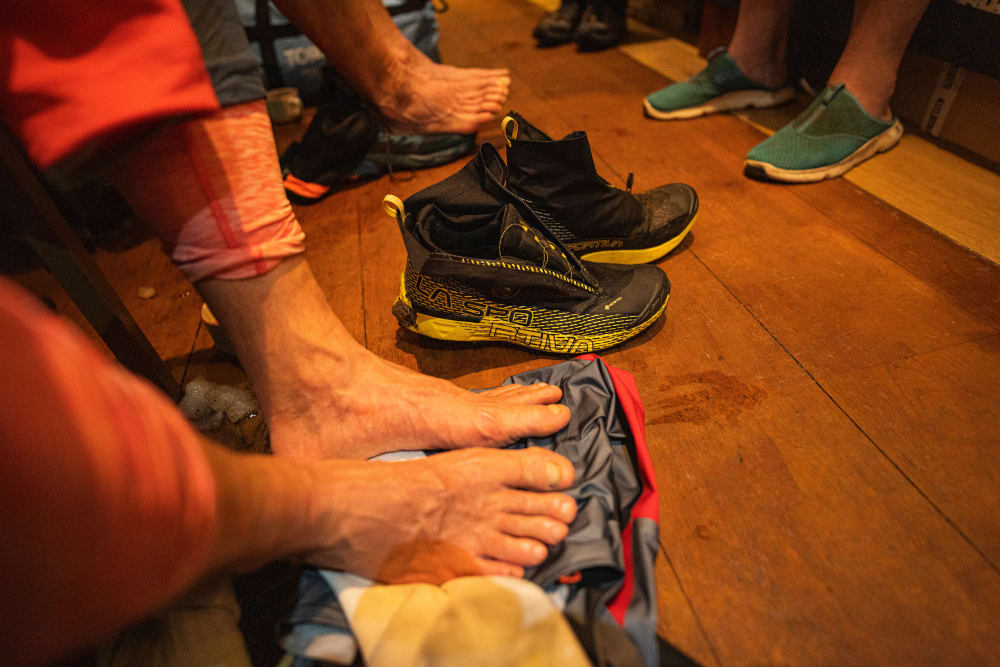
Kirk Yetholm: Completely blister free, dry feet. (Photo c/o Steve Ashworth)
Lower Body:
All through training including in sub zero temperatures for many hours, I'd worn one pair of tights and lightweight waterproof trousers. But in the race this was simply not enough. I ended up putting on a second pair of tights and then a waterproof trouser. I needed two pairs of tights to stay warm enough at the coldest times. Remembering then that these stayed largely dry through the race, I didn't touch my spare/ third pair but you need to carry one additional pair to that which you are wearing. I can't see getting away with less than three pairs of tights is viable, and a fourth would be wise.
As for the trousers, the Drizzle Pant (unisex) is a light, tapered running waterproof trouser, you feel like you can move fast in them. This was good for almost everything, you could put on a heavier Gore-Tex weight trouser in wetter weather however, that could be a valuable addition.
On the lower half, Damian Hall, moving on the whole much faster (than almost anyone else!) found that one pair of tights was often enough, with a pair of lightweight waterproof trousers over the top just for the very worst sections. But certainly for us slower movers a bit more protection is worth getting used to in training.
Montane Tight / (Womens Edition) - 3 Pairs
La Sportiva Drizzle Pant
Montane Spirit Lite Gore-Tex Waterproof Trouser
Upper Body:
This is a huge area, clearly. A good mountain layering system and an understanding of that is worth looking at. I know some runners will simply stick a Buffalo Jacket on and that'll cover almost anything they need. But I prefer the layering because it allows flexibility around conditions.
You should look at having a base layer. Two mid-layers - ideally a breathable fleece type material and a heavier weight fleece jacket, a primaloft jacket and two outer shells - a windproof and a waterproof.
For the majority of the Spine I had on six layers. Base Layer - La Sportiva Jubilee. Mid-weight fleece - the OMM Core Jacket which is super light, breathable and packs suprisingly small. A La Sportiva zip up fleece hoodie / Montane Protium Hooded Fleece. My La Sportiva Primaloft jacket. My Blizzard Windproof. A Montane Gore-Tex Active outer shell which I had on in the wet/ snow showers only. In training, I never had more than three layers on. But thermo-regulation goes out of the window several days in and you need to anticipate wearing far more than you ever will in preparation.
You then also need to have back ups for these layers. They will get wet at some stage. Having spares in your pack and your drop bag, is essential. Here's how and why.
Before a base layer for us men, Eddie Sutton adds 'this sports bra is thick (think free extra warmth) but has no seams and a large surface area to protect back. I had no chafing under arms or on back and it never felt wet so I didn’t get cold.'
A good base layer needs to be able to move moisture away from your body whilst insulating to a high degree here. The truth is at the Spine you are only really sweating up on climbs and even then if you are, you need to look at your effort level. I had several, one on me, one in the bag (that is the mandatory kit rule - one spare base layer not in use) and then a couple in the drop bag.
A good quality Waterproof Jacket is obviously crucial. Whilst a 10k/10k lightweight jacket will pass kit check, it's absolutely inappropriate to start this race with something that lightweight. The minimum level I'd suggest for the race is Gore-Tex Active. Right now we have the privielege of being able to wear a Gore level jacket which weighs close to nothing. The jacket I had for the majority of the race was the Montane Phase Nano. This is the evolution of the Spine Jacket. They are both Gore-Tex Active which translates to much greater protection than any of the other lightweight (10k - 20k range) jackets, durable, adjustable hood and hem and extremely lightweight. The womens edition of the Phase Nano is not out until September 2023. So the Spine jacket for both men and women and then the Phase Nano Mens from Spring and Womens from Autumn 2023 are the pick of the bunch for me.
Eddie Sutton comments 'I had run in a montane spine jacket for a few years size 10 one…then about a month before the race I purchased a size 12 one which I wore for the race and was so pleased I did. It enabled me to wear more layers underneath, I had more mobility and it was easier to get the hood up and down. I then took the size 10 in my drop bag ready to double layer if I needed to but we had a dry year!'
Some will point to needing heavier jackets than this - Gore-Tex Pro, higher denier grade material will stand up longer to bad weather, but that is personal preference - again weight vs packability vs protection - I believe Gore-Tex Active in these latest Montane jackets is the way forward.
You could certainly argue the case for needing one or two spare jackets too - if you are soaked through and keen to leave a check point in a hurry.
I would put a good windproof up there as just as important as a waterproof. There were times during the race where the wind was up to 40mph and on a -6 temperature reduced wind chill to -15. That cuts straight through a waterproof because of the nature of the material, where a windproof offers substantially more warmth/ protection. It still amazes me how a garment I use almost every day is so neglected in the running world. The Blizzard and Briza are nnot much over 100 grams and provide that layer of protection.
Finally the Primaloft layer, go for primaloft and not down. Primaloft still works as an insulating layer when it wets out but down does not.
M&S Reversible Seamless Sports Bra
La Sportiva Jubilee Base Layer (La Sportiva Blaze - Womens Equivalent) x 4
OMM Core Jacket Mens / Womens
Montane Protium Lite Mid-Layer Hooded Fleece Mens / Womens
Montane Phase Nano Mens / Montane Spine Jacket Womens
La Sportiva Blizzard Windproof (La Sportiva Briza - Womens Equivalent)
Headwear:
The main way you will regulate your temperature during the race is by removing or adding hat/ headwear and hoods. Far simpler and quicker than removing layers. The Core Beanie from OMM is breathable, so you don't get a sweaty head. It weighs next to nothing and is made out of primaloft active.
Another good option is a headband which allows your head to release the heat whilst ensuring you don't get cold ears, which can be a real issue.
Hoods up or down in conjunction with how cold / windy it is - the hood on your windproof being the main one to use.
I also wore a Weather Resistant/ Waterproof Cap for the first day when it rained hardest, just to re-inforce the peaked hood on the waterproof jacket and ensure rain stayed off of my face.
Take plenty of buffs. We all have them. Good for face covering, extra warmth/ neck cover, head cover and of course wiping stuff up!
OMM Core Beanie x 2
OMM Kamleika Waterproof Cap
Centurion Versatile Head and Neck Wear
Gloves
Understanding combinations of gloves based on how cold and wet your hands might get is obviously as important as any other facet of your kit. If you lose operation of your fingers, you can't eat, undo bottle caps, undo zips/ change clothing. Basically somewhere between inconvenient and dangerous. Getting into this situation was the defining factor for me in bailing off of a second Barkley loop in 2019! I got my kit wrong when the weather turned very quickly and couldnt' navigate or do my jacket up.
A liner glove, with fingers is worthwile and worth having several pairs of. I'd start with one on and one in your bag (mandatory kit). Then a couple more spares in your drop bags.
As a warm overmitt, always go for Primaloft over Down, because when they get wet - the primaloft will still work as an insulating layer. The Montane Prism Dryline is their warm Prism Mitt, super soft, comfortable and light, but with a pertex waterproof layer. I had three pairs. One on. A spare in my pack. One in my drop bag.
Then a waterproof outer glove for really harsh conditions - the Minimus overmitt also from Montane. Just one pair of those.
Montane Trail Glove (liner glove) Mens/ Womens x 4
Montane Prism Dryline Mitt or Mens Glove / Womens Glove as per preference x 3
Montane Minimus Waterproof Mitt
Pack/ Belt:
During the race I used 2 different packs. I started out with an old S/Lab Peak 20 which was a skimo pack from 2017 - basically an old faithful. Before I got hold of a Montane Gecko 20. It was a case of using what I was used to. I switched to the Gecko 20 at Middleton when the back zip failed on the Salomon and that must have been fate. Because the comfort level of the Gecko is incredible. For me it is the superior option and I wished I had started in it. The best features in my opinion are the adjustable straps across the front which allow cinching around unknown layers of clothing, and the comfortable waist belt that takes some of the load off of your shoulders. But particularly the soft elastane blended material and side pockets. Unlike almost any other pack you can reach straight into them, just down of your waist but close to the front, and stuff them full of almost anything you might need on the run. Honestly they are like Mary Poppins' bag. The fit is exceptional, so comfortable and despite the weight you barely notice you have it on. For me, there was always ample space in the back - I packed light but then added a complete set of spare clothing on the top for easy access and there was ample room. I also used a Naked Band for additional space early in the race, particularly useful for excess nutrition.
Eddie sutton also used the same back and trained and raced exclusively with it. She comments 'it's a super comfortable pack, I didn’t feel the weight or pack rubbing (but I trained a lot with the pack too!) I brought an extra chest strap from montane and attached that high up which made a huge difference too.'
For further space, the OMM Chest Pod is compatible with almost any vest or pack, by adapating the fastenings that are provided with it - giving you front access to another 4 litres. I have never found I have needed this, but many in the race use this set up.
For greater capacity - if you are someone who plans to carry bulkier jackets, extra food, or less packable sleeping bags etc, then the best 30 litre option is the UD Fastpack 30, or FastpackHer 30. Again with the belt added for more space.
Montane Gecko VP20+
Naked Waist Band
OMM Chest Pod
Ultimate Direction Fastpack 30
Ultimate Direction FastpackHer 30
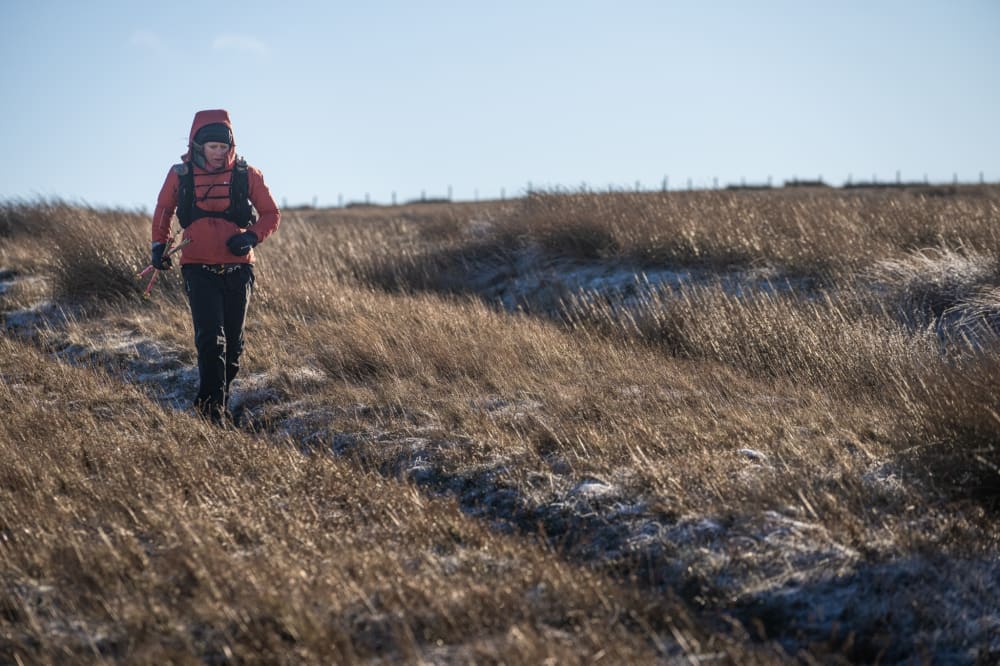
Centurion Coach Eddie Sutton rocking the Montane Gecko VP20+ en route to third place at the 2023 event (Photo: Steve Ashworth)
Lighting:
My go to lamp for the last 3-4 years now has been the Petzl Swift RL. Light, packable, easy to change rechargeable battery, long lasting and plenty of light and power. But. I found out during the first night that the lamp didn't like just how cold it was here. It's not been asked to do that duration in that cold before and because the battery was front mounted on my head, it was more exposed to that cold and seemed to drain quickly. That is anecdotal, lithium batteries should not drain any faster in that level of cold per se but that was my experience here. The batteries were all fully charged.
So I switched to my Petzl Nao RL which is Petzl's newest headlamp offering. On low reactive setting I got tons of light, more than I ever needed, and one fully charged battery lasted over 20 hours. I would only ever choose this lamp again. It's light, the battery is on the back which balances the weight out on your head, and crucially means it is protected from the bitter cold by your hood/ gets less cold.
A rear Red LED is mandatory. Rather than a cheap one which will likely break, I attach a Petzl E+Lite which has the added bonus of being usable as a back up emergency lamp with several other settings.
Petzl Nao RL x 2
Spare Nao RL R1 Batteries - x 4
Petzl E+Lite
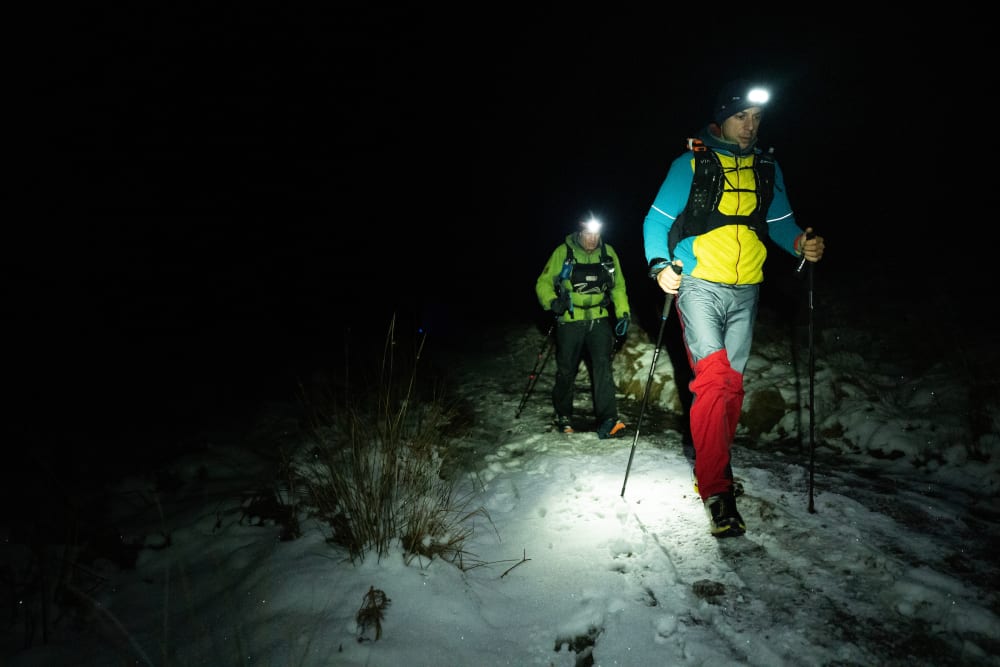
20 hours plus on low reactive setting with the Petzl Nao RL - always enough light to move well. (Photo: Steve Ashworth)
Sleep System:
Full disclosure here, I used this in training and on the freezing cold floor in Bellingham but I did not Bivi out during the race. The Thermarest Hyperion has a comfort rating of 0 degrees C. It is super lightweight, but immensely comfortable and feels substantial despite how small it packs down. It is the minimum rating to pass kit check, but honestly with the Mat, Bivi and Clothing you have, I can never see more than this bag, being required. You can of course find other marginally lighter, extremely expensive alternatives but with performance vs packability vs weight, this is the optimum bag for me.
The sleep pad - I opted for the lightest as once again, I wasn't planning on a bivi unless in emergency - but I am happy having bivi'd on it before that whilst not the most comfortable night, as an insulating layer it does everything you need eg. gets you off of the freezing cold ground which is conducting your body heat away very quickly indeed. The Neo-Air Uberlite inflates extremely quickly and is a pass at kit check. Again it feels substantial. To me, the mat is the least important thing. If you try to inflate a mat like this with little or no shelter in high wind in an emergency you may as well be holding onto a kite. You need to get the bivi out first and try to inflate the mat inside of it whilst pinned down and ideally behind shelter. You need to practice these things in training!
With the bivi, I have again gone super lightweight, almost as light as you can go. The less durable bags eg SOL will fail at kit check. This is a waterproof bag with taped seams and perfectly adequate to keep you protected for short sleeps or awaiting assistance. This isn't a bag I'd hang out in year round for comfort - but that isn't why I am carrying it during this event.
Thermarest Hyperion 32F/0C Sleeping Bag
Thermarest Neo-Air Uberlite Sleeping Pad
Terra Nova Moonlite Bivi - We will have these in stock from end of March 2023.
Navigation:
The Pennine Way is not a well marked trail. You will find finger posts and the acorn symbol in lots of places. But nothing it all in much greater amounts. Map and compass are mandatory kit and for good reason. If you'd had your watch die and/ or your OS App jumping all over the place in heavy clag on the high mountains, you need to be able to use them. Again for me it was a hard lesson on top of Red Pike by myself winter in serious conditions when the electronics all failed that forced me to take 'thumbing the map' more seriously. But, I would use the maps as a back up here because you ideally want hands free for poles, eating and gates. So use the excellent GPX trace, uploaded on your watch. It will tell you when you are going off course and when to make a turn. The Coros Vertix 2 has the longest battery life of any watch going, so we stock that to try to ensure least charging time.
The handheld GPS you will see some using as a primary navigation device but more often than not it is a back-up. We used it on the Cam Road section on the longest stretch between check points, when my watch died. The Garmin 66S is easy to use even with big gloves on, takes 3 x AA batteries which are easily changed and is essentially bomb proof navigation. You need to learn to use the funcationality before you head out, you will need to upload the right maps for the Pennine Way - it doesn't come with these built in and you will be best off leaving it switched on, so if you do need to use it it is already there with the route and your position on it, not loading up in harsh conditions as you stand around waiting for it.
Reference a compass, I personally prefer a thumb / orienteering compass, but that won't pass kit check here so get a solid reliable compass like the Silva Ranger instead.
Coros Vertix 2
Pennine Way Harveys Map: North and South
Garmin 66s Handheld GPS
Silva Ranger Compass (coming to store soon!)
Poles:
I'm not sure if anyone went without poles but I'd be suprised. For stability, for measuring the depth of bogs - seriously, and for more efficient forward movement they have to be considered essential. Whilst I am a huge fan of Leki's Ultratrail FX.One Superlight poles which I used for TDG, I have always used a Black Diamond Carbon Z or FLZ pole when wearing gloves. They are super light, durable, fold down quickly and easily when out of use and most importantly have an easy to adjust hand strap so that I am not trying to squeeze the otherwise excellent Leki Shark Glove system over several layers of changing glove types. The FLZ have the added bonus of being height adjustable on the move.
Poles: Black Diamond Distance Z Poles
Stove/ Cooking / Eating System:
Aim for me is to be able to boil water quickly and simply but for it to be reliable. Whilst meths is lighter and more packable, the chance of a leak and the hassle of the longer burn time don't make it worth it for me. So I like gas options. Stoves are tiny these days and I use an Alpkit Kraku screwed straight into the gas canister, with storm proof matches to light. Remember you can't blow these out! So get used to letting them burn out in your hand like a sparkler! The Bugaboo mug from GSI is titanium so super light and useful obviously for drinks at the CPs - it is also good to use on the stove and boils extremely quickly, the 400ml limit you need to carry for kit - also coincidentally the amount you need for most rehydrated meals. I'd say good going less than 5 minutes to brew. The bugaboo will be HOT when you pick it up, but the handle is separated - so make sure you wear a glove and within a minute or two is fine to hold. Again, I wouldn't use this system day to day but on the spine (the bugaboo is not meant for this, it will eventually start to deform if you burn it for ages and ages) but it's everything I need here and more. The Titanium Spork from Optimus weighs nothing.
For flasks/ water, it's worth carrying insulated soft flasks so that your fluid has less chance of freezing. My flasks froze several times leaving me an issue on those sections. It is also worth carrying a filter bottle which you can then decant, if you choose to or need to fill up from questionable sources.
Alpkit Kraku Stove
GSI 110g Isobutane Gas Compatible with that stove
LifeSystems Storm Proof Matches
GSI Bugaboo Cup
Optimus Spork
Salomon insulated soft flasks x 2
Katadyn Befree Filter Flask 600ml
Medical
Take a decent medical kit with you. Look at what is on the kit list, ensure you have it all but also think - what do I really need to carry? Pre-taping feet and having the right, quick to use tools to do that is something to look at pre-race. I am not a big fan of pre taping, but the conditions at the Spine are unique and by adding tape strategically you can often offset some of the worst problems. Remember, don't get into a check point and rip the tape off. Be careful. Your skin will be moist underneath and will tear more easily, so take extreme care when removing and replacing tape.
Lifesystems Waterproof Micro First Aid Kit
Lifesystems Blister First Aid Kit
Other Mandatory Kit
Lifesystems Hurricane Whistle - far better than the one that came free with your pack. They will make you blow it at kit check!
Swiss Card Knife/ Scissors - This is an expensive option but essentially gives you lots of other useful kit for almost no weight/ size. The blade passes kit check in length. Cheaper replicas are available.
Bolle Safety Goggles - Light and cheap. Tinted expensive ski/ mountain goggles won't pass kit check, you need a clear goggle. These are worth getting used to in training as they need to be adjusted to feel comfortable. Lots of similar options in their range, must have a headband.
GSI Cathole 'Poo' Trowel and Tissues plus poo bags
Food and Drink
This is perhaps the most individual area of all. My advice to you is to consider carrying not just the 3000kcal minimum you are required to have, leaving each check point, but ensure what you have is going to be appealing and easy to consume over very long periods.
In races in the past I have consumed exclusively gels - including at Western States in 2011 where I ate 70 Gu's. For this race I took almost no sports nutrition with the exception of some Maurten 320 CAF 100 drink mix primarily for the caffeine overnight.
The other critical component is thinking about freeze dried meals. You won't need these at the check points which are very well stocked, but you will benefit from them at certain points in between. Either at the 0.5 check points or at the pop up locations with MRT where hot water is given. Or again, if you stop to brew up yourself.
I ate all of these things during the race and these options worked best for me. This is a very individual area however.
Expedition Foods Freeze Dried Meals
Gu Stroopwaffels
Chia Charge Mini Bars
Clif Bar Mini's
Maurten 320 CAF 100
Succeed! S! Caps
Non Mandatory but Borderline!
Battery Packs: I used two larger power banks here in my drop bag, to charge batteries between check points. And then two smaller ones here that I carried on my person. Plug sockets whilst available at some check points are far from guaranteed. This system allowed me to charge everything for 5 days, with plenty of power to spare, without ever needing mains power. My watch, headlamp and phone cables, I carried in my bag to recharge on the go - I only needed to do that between Hebden and Hawes due to the length of that section. But it was nice to know I had that option if I needed.
Lifesystems Ear Plugs - It's noisy in the bunk rooms!
Anti Chafe: Bodyglide
Dry Bags: The Ortlieb 13 litre dry bag fits nicely in the Montane Gecko 20 and is truly waterproof/ hard wearing. I then use lighter Exped Fold Lite Dry bags for other kit and my bags to go inside drop bag bags.
Repair Kit: OMM Waterproof Patches, Cable ties, Duct Tape, KT Tape, bungee. Shoe, pack, pole, clothing repairs are almost certainly going to be required at some stage.
BIO
My Spine Race finish in 2023 came 17 years almost to the day, fter my first ultra.
I began in 2005 and my first big adventure was the MDS. I went on to become the youngest finisher at the time of the 4Deserts Series including multi-stage races across the Gobi, Atacama, Sahara Deserts as well as on Antarctica. In 2009 I began running 100 milers and have finished quite a few of the bigger marquee events to date including:
Western States, Leadville, UTMB, Arc of Attrition, Lakeland, WHW Race, Caesars Camp, Old Dominion, Rocky Raccoon (x 5), Autumn 100 etc.
I've also explored the longer single stage races finishing Badwater, Spartathlon, GUCR, many 24hr races including 2 Silver medals in a GB vest and more recently the Tor Des Geants.
In 2011 I started Centurion Running and we've had a stable of 50 and 100 mile races since that time. I have personally Rd'd over 50 races of 100 miles or more and 30 x 50 milers in that time.
Outside of racing I ran the Bob Graham in 2014, the Paddy Buckley in 2021 and the Charlie Ramsay in 2022 made me the 73rd person to complete the Big 3 in under 24 hours. In 2015, I ran across Iceland with Robbie Britton - a very cold expedition over 7 days/ 200 miles. I completed my Wainwrights journey many years ago with many wonderful solo days out in the hills in all conditions.
In addition I've run 150 marathon+ events with a PB of 2:43 and finished both Ironman and long distance cycling events.













